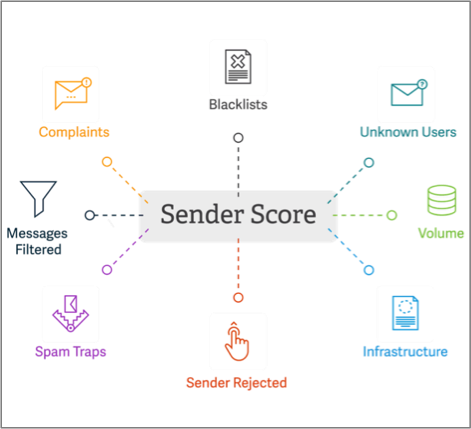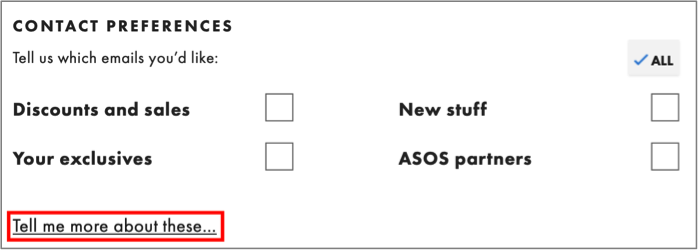Email Sender and Domain Reputation
Sender Score: A Credit Score for IP Address Reputation
minute read

Sender Score is the first stop for many in determining the health of their IP reputation, and if it isn’t yours, then it should be. IP reputation remains critically important to deliverability, and at Return Path, we can help, by providing you with a free credit rating for your IP address, in the form of a score from zero to 100.
It was once the only standout performer within the elusive 91-100 Sender Score band; however, this has now become the norm. Now your email program will stand out by not being a best-practice sender. Of the volume sent in 2018, 42 percent was by those with a score in the top tier of Sender Score. To further represent the importance of maintaining a healthy IP reputation; Microsoft states it is one of the key gateway checks “… An incoming message initially passes through connection filtering, which checks the sender’s reputation and inspects the message for malware …”.
What is the impact of a low Sender Score?
Our newly released 2019 Sender Score Benchmark found that if your Sender Score is below 91 your inbox placement rate on average will be at least 20 percent lower; meaning those crucial emails will not be getting into your customer’s inboxes.
So how do I improve and optimize my Sender Score?
Understanding how Sender Score is calculated is important; there are eight reputational metrics taken into account.
Today we are going to look at the three you can instantly act upon—complaints, unknown users, and spam traps.
Complaints
Subscribers complaining about emails continues to be a large driver for poor inbox placement as a result of diminished IP reputation. The trend for 2019 shows the impact of GDPR through increased levels of messages marked as spam during the ‘GDPR period’ of April to May 2018, but also an increased level of consumer awareness of the emails they are receiving. Complaint rates on emails received from senders with a Sender Score between 11 and 100 saw a doubling of the average complaint rate from 2017 to 2018.
No bracket of Sender Score and no best-in-class sender has fully absolved their program of complaints; however, if you do find yourself with a persistent issue, there are several ways by which you can immediately help alleviate this negative metric.
- Feedback loops (FBLs): Firstly, ensure that you are processing complaints via critical feedback loops like Microsoft’s Junk Email Reporting Program, Verizon Media’s Complaint Feedback Loop, and Return Path’s Universal Feedback Loop. Your first question may be “Why would I want to lose subscribers because they complained about one email?”. The simple answer is a high complaint rate can have a significant impact on your inbox placement rate, and these subscribers may be inadvertently causing deliverability to suffer, resulting in loyal subscribers not receiving your precious cargo in the inbox.
- Setting expectations: The best way to stop people complaining is not to give them a reason. Start with setting the correct expectations at the point of sign-up. Offering a preference centre is also a good option, and a great way to ensure you are acquiring subscribers primed for engagement is to include it on the sign-up form like ASOS does below.
Unknown Users
As the name suggests, these are email addresses within your database that do not exist at the mailbox provider. When emailing unknown users, the mailbox provider will respond with a 5xx bounce code, which will negatively impact your Sender Score. Those with a top-tier Sender Score of 91+ will on average have an unknown user rate of only 0.9 percent. To keep unknown users off your list, try the following.
- Real-time list validation: Stopping unknown users is best done at the source. Validating the email addresses at the point of acquisition, by using a service like BriteVerify, will ensure you are using a good-quality list. Groupon uses email validation on their sign-up form to try and avoid commonly misspelled email addresses entering the database.
- Bounce Management: On the other hand, if you see an indication that unknown users within your database are already an issue, you should ensure that effective bounce management processing is in place. Processing and removing all hard bounces at the first incident and removing all soft bounces on a three-strike rule is the industry’s best practice here.
Spam Traps
A mailbox provider’s job is to stop bad emails from bad senders from reaching their valuable customer’s inboxes. One mechanism by which they do this is through the operation of spam traps, which come in two varieties; recycled and pristine. The former are mailboxes that used to be in full operation for a consumer, but activity has lapsed, and the mailbox provider has turned them into a spam trap. Pristine traps are mailboxes created for the specific use of catching poor senders; they should never receive any emails.
Underlining the importance of list hygiene, senders that are consistently hitting traps have a very poor IP reputation and therefore poor deliverability. So, how do you ensure you are avoiding these traps?
- List acquisition: This one is simple: do not purchase or rent email lists.
- Confirmed or double opt-in: Using either of the above will give you the assurance that those email addresses added to your database are real consumers, who want to both receive and engage with your campaigns.
To wrap up, IP reputation remains a key driver for deliverability. Mailbox providers rely on reputation to decide whether to let emails through to their inbox or to filter them to the spam folder. The upshot of this is that Sender Score remains a critical tool for anybody running an email program in today’s world that relies on trust and reputation. Check your email reputation.
Want to learn more about how reputation impacts your email programs performance? Download the 2019 Sender Score Benchmark.




